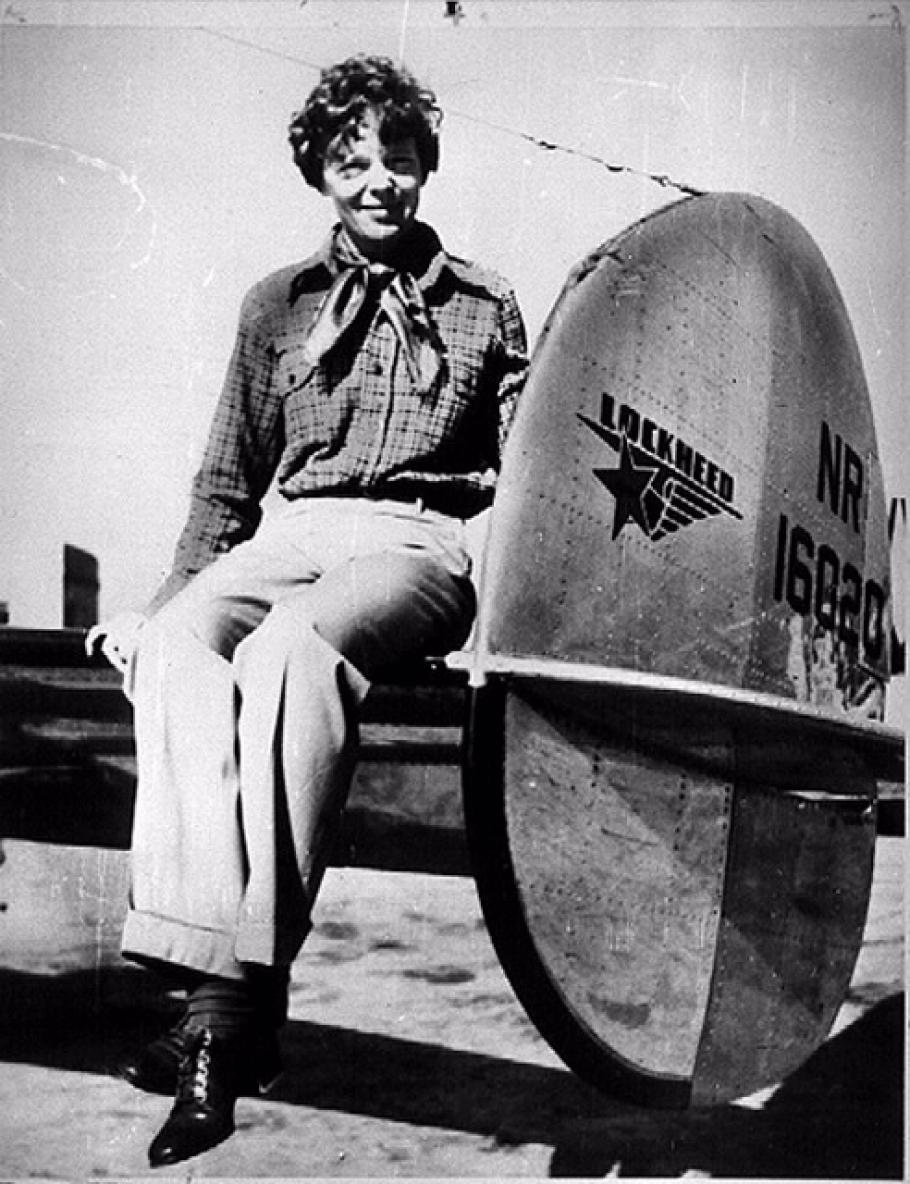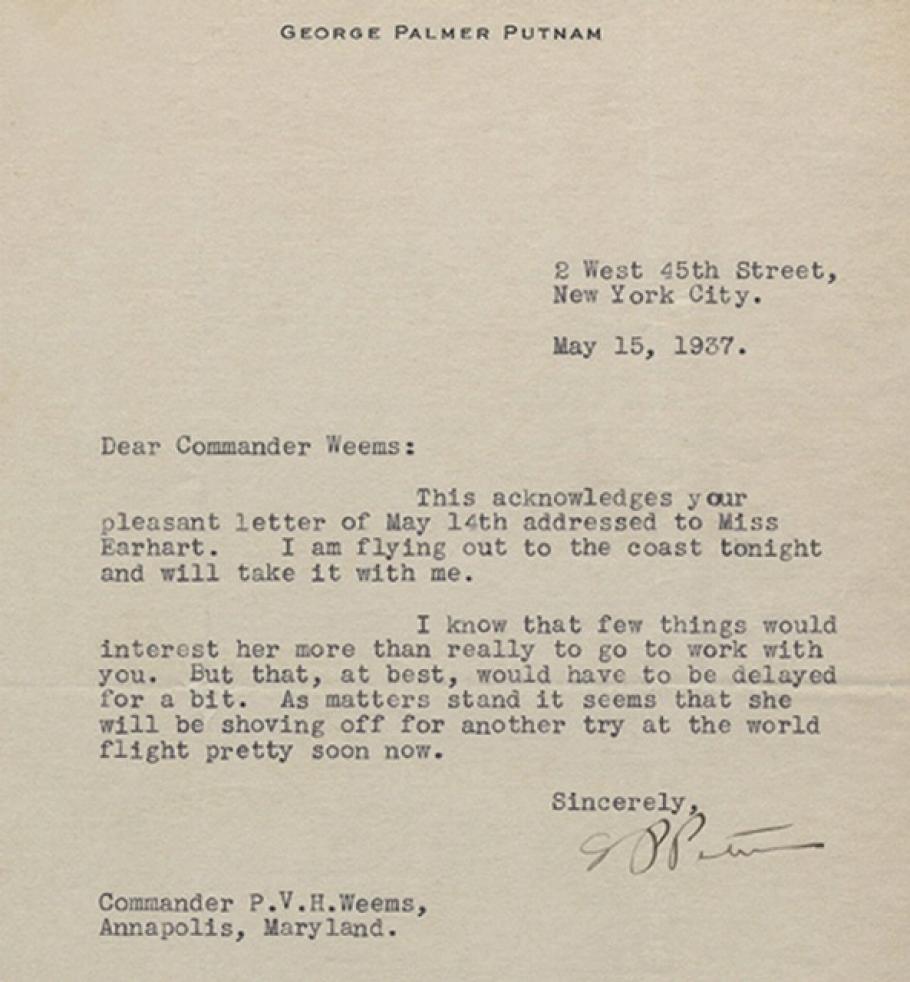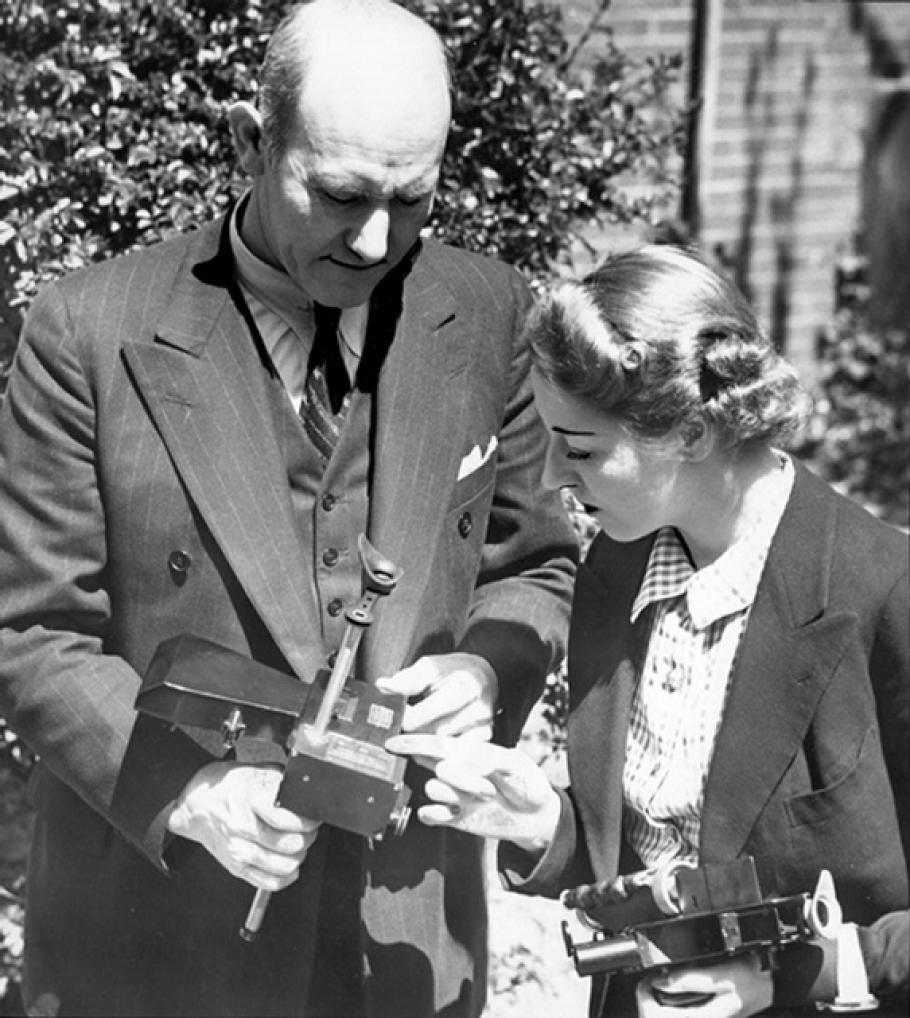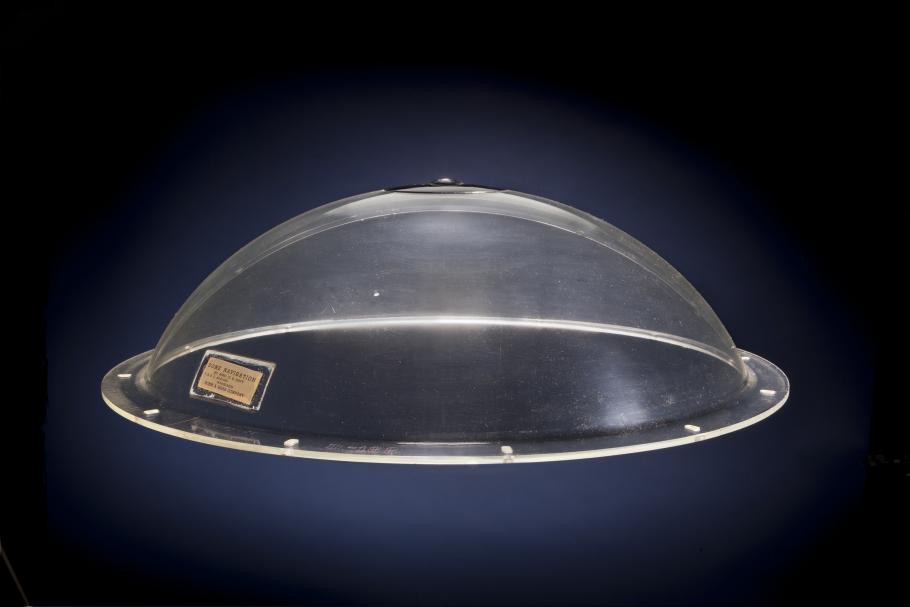The recent seventy-fifth anniversary of the disappearance of Amelia Earhart and her navigator, Fred Noonan, stirred up considerable media attention – particularly in light of another expedition to the South Pacific in the hopes of solving the mystery. While the fate of Earhart has enthralled the public since 1937, the story of how Earhart figures into the larger history of air navigation and long-distance flying is often overlooked.
Viewed as a stand-alone episode, the tale of Earhart’s last flight is confusing. Did she have the right training and equipment? If Fred Noonan was one of the greatest aerial navigators of the time, how did they get lost? The evidence for these questions is often vague and contradictory. One way to come to terms with the moment is to look at the larger historical context of air navigation at that time. This musing is not meant to provide definitive clues to the disappearance, but rather to provide some further topics of discussion that might be useful for future scholarship. How did Earhart’s planning fit with other flights over the South Pacific? How did their navigational training compare with that of other aviators? And, what was the professional standard of air navigation at the time? In less than two months, the National Air and Space Museum will unveil a new permanent gallery – Time and Navigation: The Untold Story of Getting From Here to There – that will in part chronicle the development of air navigation as a profession. Today, the navigator as a crew member has largely disappeared from most commercial and military long-distance operations, replaced by microprocessors in the form of GPS and inertial navigation systems, but from the 1930s to the 1980s, the navigator was an essential crewmember on many long-distance commercial and military flights.
Understanding how Earhart fits into the story of this profession provides some useful insights into the evolution of long range flight on the eve of World War II. While Europe and the United States were developing networks of radio beacons and direction finding stations over their own territory, transoceanic navigation was only reliable with proficiency in celestial and dead reckoning navigation. Though these techniques were tried and true in maritime navigation, adapting them to the aerial environment was a new challenge. The cramped confines of aircraft, high speeds, variable weather, and turbulence greatly complicated the process of fixing position. Charles Lindbergh’s reliance on nothing more than an earth inductor compass and a simple clock for finding his way during his 1927 solo transatlantic flight was emblematic of the often dangerous or ineffective state of air navigation. Though it worked well for Lindbergh who was the beneficiary of ideal wind conditions at the time of his flight, almost half of his peers attempting long distance flights that year either lost their lives or had their flights end in near disaster. However, the decade between Lindbergh's Paris flight and the disappearance of Amelia Earhart witnessed a transformation of aerial navigation technology and practice. A small community of innovators worked to find better tools and techniques. One of these was a Navy Lt. Commander named Phillip Van Horn Weems. He developed simplified methods of celestial navigation that, when combined with improved sextants, provided a reliable means of determining position (either a fix or a “line of position) when the sun or stars could be seen. By 1928, Weems had gone into business teaching air navigation. His initial students and clients included Charles Lindbergh, eager to find a better way than simply relying on luck to cross oceans (see the author’s article in Air and Space Magazine on this topic), polar explorer Lincoln Ellsworth, and Harold Gatty, the soon-to-be-famous navigator of Wiley Post’s Winnie Mae on its around-the-world record stating flight of 1931. Despite the efforts of Weems and Gatty (who managed the Weems System of Navigation for a period), by 1937, the navigator as a dedicated non-pilot aircrew member was still a largely untested idea. While both the Army Air Corps and (to a lesser extent) Navy, were teaching air navigation with the tools and techniques advanced by Weems, Gatty and Albert Hegenberger (the Air Corps’ navigation authority), navigation was still seen as the responsibility of the aircraft commander or pilot. Rather, it was Pan American Airways and record-setters like Wiley Post that were defining the role of a dedicated non-pilot air navigator. Fred Noonan was on the cusp of this transition and his competence earned him a place as Pan Am’s lead navigator for the trans-pacific trials of a new class of “Flying Clipper.” Earhart, like most distance fliers of the time, elected to concentrate on piloting and intended to leave the technical aspects of her flight to two navigators - Noonan and Harry Manning. Manning lacked the aerial expertise Noonan had acquired from Tornich and Weems, but was a celebrated maritime navigator and had the radio skills that both Earhart and Noonan lacked. Originally, Earhart intended on having Noonan along only for the dangerous Hawaii - Howland Island leg on her original westbound route. She also intended on dropping Manning after completing the remainder of the Pacific hop. Unfortunately, Earhart became dissatisfied with Manning before her final around-the-world attempt so that Noonan became the sole navigator and the expedition was left without an experienced radio operator when she set off on her second around the world attempt in June 1937.
Earhart’s first around-the-world attempt ended in near disaster on March 21, 1937, when she substantially damaged her Lockheed Electra 10E after losing control during takeoff from Hawaii’s Luke Field bound for Howland Island. While the plane was being repaired, Weems wrote the letter below to Earhart encouraging her to undergo navigation training in the manner of Britain’s top female aviator, Amy Johnson. He also called out what has been widely regarded as one of Earhart’ and Noonan’s greatest failings in anticipation of the flight – their lack of proficiency in the use of Morse code, which was essential for gaining long range bearings from the Coast Guard cutter specially stationed at Howland Island for this purpose. However, even though critical for navigation, Weems’ suggestion is somewhat remarkable as radiotelegraphy was considered an unusual specialization for an aviator, or even a navigator, at the time. Well into the World War II era, navigators and radio operators were considered two entirely different occupational tracks. In the military, the radio operator was considered a less technically demanding skillset and was usually assigned to enlisted personnel, while navigators were usually officers (often washed-out pilots).
After Weems’ initial offer to Earhart, her publishing magnate husband, G. P. Putnam, responded the next day to Weems’ offer, kindly rejecting it. This brief and forgotten exchange of letters sheds further light on the frequent criticism of Earhart from both her contemporary peers and from historians of her tendency to be dismissive of training in the more technical aspects of aviation. Weems' invocation of Amy Johnson’s navigational skill demonstrates that there was indeed a cadre of very competent female aviators skilled in navigation in a way that Earhart was not. In addition to Johnson and Anne Morrow Lindbergh, several other prominent female aviators of the time learned under the Weems System of Navigation. Among these were the Romanian Baroness Lisette Kapri, Dorothy “Dot” Lemon, and Mary Tornich, who was one of the Weems System of Navigation principal instructors in the late 1930s, and who appears to have undertaken much of Noonan’s air navigation instruction. From this perspective, Earhart may be seen as inadequately trained. However, there was certainly no clear consensus on what standard of navigational skill was required for distance fliers at the time. For instance, Wiley Post, at the height of his fame in 1933 (earned for his solo around-the-world flight in the Winnie Mae), was no more a navigator than Earhart. He employed Gatty in 1931 in the same manner as Earhart did with Noonan. In 1933, Post, like Earhart in 1937, put blind faith into new technology - a new Air Corps radio compass and a Sperry autopilot. The gamble paid off for Post, but not Earhart. The most obvious distinction between the two is that Post seemed to have a greater interest, familiarity and comfort with the technology.
Whether or not Weems' instruction would have helped Earhart cannot be known. Perhaps it may have made her realize that her “flying laboratory” was that in name only. The Lockheed was not well fitted for navigation. It lacked a rooftop hatch or viewing port for unobstructed celestial observations and none of their navigational equipment, save for a Bendix direction finding radio, could be considered state-of-the-art. Unfortunately, Earhart struggled with the Bendix radio during the flight. Its newness, mechanical unreliability and Earhart’s inexperience with the equipment likely reduced its utility. However, the most vivid illustration of how poorly equipped the Electra was can be seen in the following year with Howard Hughes’ around-the-world flight in a Lockheed 14 that was similar to Earhart’s 10E, but which was truly a flying laboratory that accommodated two navigators and a host of new navigational equipment. This included a new averaging sextant, a new drift sight, new dead reckoning computers, a special observation portal, and a remarkable (and secret) line of position computer made by Fairchild-Maxson (see photo). If the loss of Earhart and Noonan had any impact on the navigational community, it may well be the thoroughness with which Hughes pursued the Army Air Corps supported flight (including filling the voids in the aircraft structure with 35,000 ping pong balls to stay afloat in the event of a ditching). The Hughes flight did much to pave the way for the approach to navigation used so effectively by bombers and other long-range aircraft over the ocean expanses during World War II, most notably by encouraging the mounting of Plexiglas astrodomes.
By the time of Earhart’s disappearance, the necessity of training in celestial navigation touted by Weems, Gatty, and Hegenberger over the previous decade had finally been heeded by many with Lindbergh being the most prominent acolyte. Lindbergh was so convinced that in 1930 he had his wife, Anne Morrow, learn celestial navigation from Gatty in her third trimester of pregnancy and then demonstrate it on a transcontinental flight. Earhart’s desire to distinguish herself led her to select a Southern route that most of her predecessors, had carefully avoided. By doing so, she also sidestepped the poor weather often found from Siberia to Alaska and perhaps alleviated her known discomfort with instrument flying. If celestial navigation was not necessarily an expected trait for distance flyers of the time, skill in “blind flying” had become mandatory. Effective navigation across the South Pacific was indeed possible in 1937, but only one person had demonstrated it could be done safely - Charles Kingsford Smith. Overshadowed by Lindbergh in the United States, Kingsford Smith's achievements are arguably more spectacular. In 1928, he made the first Pacific crossing from the United States to Australia in the Fokker F.VII Southern Cross with three additional crewmembers. In 1935, he repeated the achievement flying eastbound in the Lockheed Altair Lady Southern Cross with P.G. Taylor as navigator. What stands in stark contrast between "Smithy's" flights and Earhart's attempt is that Kingsford Smith chose an aircraft with adequate range. This allowed him on both flights to make the "jump" between Fiji and Hawaii - very large targets.
For reasons that can only be speculative, Earhart selected the fast and flashy Lockheed 10E. It was an extremely attractive aircraft at that time for distance flying - except for crossing the South Pacific, for which it did not have the range. The issues of range and geopolitical considerations forced Earhart into the selection of the remote, isolated, and tiny Howland Island. Perhaps most importantly, the 10E's twin engines gave Earhart a false sense of security. In many situations, the ability to sustain flight on one engine was highly desirable as it could prevent forced landings in unforgiving terrain. Unfortunately, over the open South Pacific, it was a major liability as it doubled the chances of engine failure, and the degraded single engine performance provided virtually no hope of reaching land in the event of a problem on the legs to and from Howland Island. Earhart would have likely been far better off with Smithy’s obsolescent single-engine Altair than the flashier 10E. However, high-profile accidents such as the fatal one in 1935 that killed Wiley Post and famed humorist Will Rogers had convinced many distance fliers that twin engine aircraft were preferable, unfortunately without much analysis of their risks. The Time and Navigation exhibition is not intended to give a lengthy exploration of the challenges faced by Earhart or speculate as to her fate, but we do represent the issues surrounding her disappearance as a cautionary moment which warned other distance fliers that lack of preparedness could be deadly. The exhibit features several of these key "Navigation Gone Wrong" episodes that prompted navigators of the time to pause briefly and reconsider the state of their profession. My own conclusion is that is that the accident chain started with the selection of a South Pacific route and the choice of the Lockheed 10E with inadequate range that then locked in the poor choice of Howland Island as the expedition's most critical way-station. The great shortfall in the Earhart's and Noonan's approach was the inability to see the magnitude of the risk they were taking in selecting Howland and gambling on the reliability of largely untested radio equipment. We may never solve the question of the final whereabouts of Earhart and Noonan, but we can understand the world in which they operated by examining the circumstances of their disappearance. If you would like to learn more, view an archive of our online conference, "Thinking Critically About Amelia Earhart's Disappearance."





